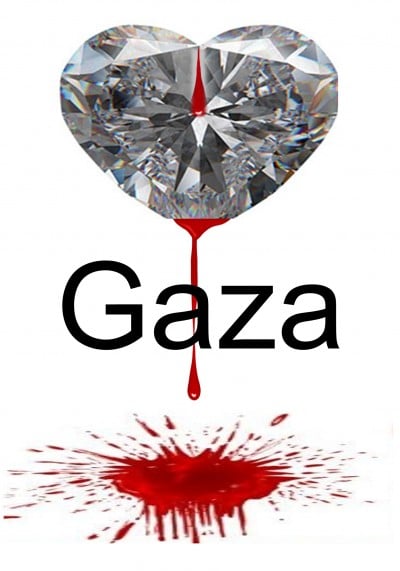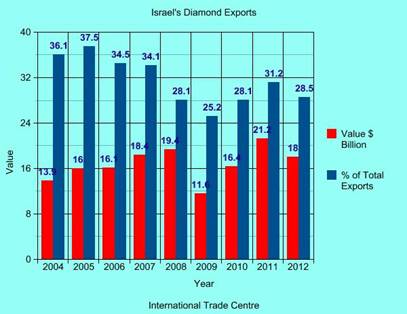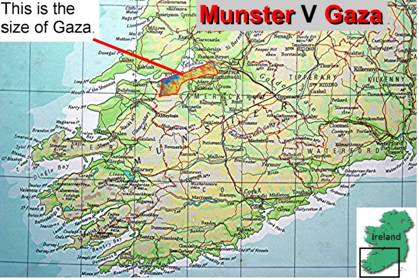Israel’s “Blood Diamonds” Boost Jeweller Profits as Gaza Bleeds

As Israel carries out yet another attack on Gaza jewellers worldwide continue to conceal the fact that blood diamonds are supporting one of the most abhorrent and prolonged injustices against a defenceless indigenous people. Israel’s “prominent and central position” in the global diamond industry has ensured that diamonds which fund war crimes in Palestine evade regulation. Consumers have been kept in the dark and lied to about the extent of the blood diamond problem
Bob Bates, senior editor with JCK magazine, is a diamond industry insider who never tires of throwing dust in the eyes of his readers as he tries to convince them that the diamond market is no longer heavily contaminated with blood diamonds. His latest broadside is aimed at Jason Miklian, a researcher who caused considerable embarrassment for the industry when an article he wrote exposed some of the serious flaws in the Kimberley Process and spawned headlines declaring that 25% of all diamonds are blood diamonds.
Figure 1 – Diamond exports that generate revenue used to fund the Israeli military account for between one quarter and one third of Israel’s exports
In the patronising attack piece Bates claims Miklian discredited his original thesis when, in a later article, he used the term “up to 25%” rather than “about 25%” and that the diamonds he referred to were illicit diamonds and not blood diamonds. Bates’ arguments fall flat and are unconvincing but his effort exposes some contradictory positions of his own when it comes to blood diamonds.
According to Bates blood diamonds are “diamonds that are associated with violence, whoever the actor.” That simple definition is one I think most people would agree with. “Conflict diamonds”, the restrictive, sanitized term introduced by the diamond industry, are defined by the Kimberley Process (KP) as “rough diamonds used by rebel movements or their allies to fund violence aimed at undermining legitimate governments” (emphasis added). When compared to “conflict diamonds” Bates’ blood diamond definition gives one some idea of the enormity of gaping hole in the Kimberley Process regulations which allows blood diamonds to freely enter the market.
Although rough diamonds associated with human rights violations by government forces are not “conflict diamonds” and, therefore, are not banned by the KP, they are blood diamonds. Similarly, cut and polished diamonds that fund human rights violations are not “conflict diamonds” but they are blood diamonds.
By restricting the remit of the KP to “conflict diamonds” and keeping public attention focused on rebel violence associated with the mining sector, the multibillion dollar trade in cut and polished blood diamonds is allowed continue unseen and unchallenged.
In a previous article titled The Other Blood Diamonds, referring to human rights violations by government forces in Angola Bates wrote:
“There isn’t the same international consensus among governments about diamonds associated with human rights abuses as there is with conflict diamonds. But really it’s hard to see the difference, at least from a consumer point of view. If they knew what was happening in Angola, most consumers would consider those gems blood diamonds.”
Now, however, Bates has rounded on Maklian for regarding “diamonds whose proceeds are used to support governments that commit human rights abuses against their own populations” as blood diamonds.
Bates says it’s “quite a broad definition, of the type that NGOs involved in the issue have deliberately avoided, because of the political morass it would raise.” NGOs avoided using this definition not because such diamonds aren’t blood diamonds but because doing so would create political problems in the KP. The NGOs that remain within the KP have clearly prioritised avoiding political turmoil over exposing the extent to which the diamond market remains contaminated with blood diamonds that fund rogue regimes. NGOs, whose first priority should be protecting the victims of diamond funded violence, should be highlighting the fact that revenue from the diamond industry continues to fund human rights violations on a massive scale and that consumers are being conned – buying diamonds that are certified as conflict-free even though a high percentage of them are funding gross human rights violations by government forces.
Global Witness, the London-based NGO that was to the fore in exposing the blood diamond wars, had no qualms about exposing the KP charade and withdrew from the scheme in 2011 after it allowed suspected blood diamonds from Zimbabwe to be certified KP compliant and sold on the international market.
The few NGOs remaining within the KP tent continue to prop up the discredited system of self-regulation and are used by the diamond industry to provide a veneer of credibility and respectability to their phony scheme.
Citing spurious examples of diamonds from Russia, some African countries and the USA Bates tries to justify the exclusion of diamonds that fund government violence being labelled blood diamonds. One, very telling, example he failed to mention was diamonds from Israel – a serial human rights offender and major force in the global diamond industry which stands accused of war crimes by the UNHRC, Amnesty International and Human Rights Watch.
The fact that the Israeli diamond industry is estimated to generate about $1 billion/yr. in funding for the Israeli military should have meant diamonds from Israel were regarded as blood diamonds and banned years ago. The vested interests that set up and control the KP, including Israel, the EU and the US, ensure these blood diamonds avail of the KP’s protective shield and are stamped conflict-free in accordance with a bogus “System of Warranties” introduced by the World Diamond Council to create the illusion that the KP regulations extend to cut and polished diamonds.
Bates’ argument that diamonds from any country accused of human rights violations could be classed as blood diamonds is a fallacious one. Unless revenue from diamonds is a significant source of funding for, or the cause of, human rights violations, as is the case in Israel and parts of Zimbabwe, then it would be difficult to make a credible case for classifying diamonds as blood diamonds.
Figure 2. The tiny Gaza strip is home to 1.6 million people two thirds of them are refugees and their descendants forcibly expelled from their homes, farms and villages inside present-day Israel in order to allow Jewish immigrants seize their property and create an ethnically cleansed electorate for the establishment of a Jewish state.
The case for banning the trade in diamonds from Israel is unquestionable. Israel’s record of unregulated nuclear weapons proliferation, war crimes and crimes against humanity, the harrowing situation of the 1.6 million Palestinians crammed into and imprisoned in the besieged Gaza strip plus the millions of Palestinian refugees and their descendants languishing in overcrowded refugee camps since 1948 and the suffering of Palestinians in the West Bank and East Jerusalem subjugated and tormented by an apartheid regime which is funded to a very significant degree by revenue from the diamond industry are compelling reasons to label diamonds from Israel blood diamonds.
Bates’ statement about the situation in Angola is even more applicable to Israel’s human rights violations:
“But of course most consumers don’t know about this issue. There hasn’t been much publicity or a consumer campaign about it. Yet that doesn’t mean there won’t be. And it could be extremely damaging if there was. The industry has every motivation in the world, for both ethical and business reasons, to get ahead of this issue now, and pressure Angolan miners and the government to clean up their act, before it comes back to bite us.”
The diamond industry in Israel is the cornerstone of the economy that generates the revenue needed to sustain a belligerent apartheid regime which commits serious human rights violations on a daily basis and ignores all attempts by the international community to broker a just and lasting peace agreement between Israelis and Palestinians.
The US market consumes 50% of the global diamond production and half of the diamonds sold there come from Israel. Given this reality it is little wonder that when the Texas Jewellers Association recently announced plans for the first ever Israel – Texas diamond fair human rights activists who favour a single democratic state in Palestine/Israel started a petition calling on the TJA to end their collaboration with the Israeli diamond industry. As Rob Bates’s said about diamonds from Angola: if they knew what was happening in Palestine, most consumers would regard those gems blood diamonds.
Sean Clinton is a human rights activist from Ireland with a particular interest in Israel/Palestine and the role diamonds play in funding the Zionist project in Palestine. He has authored several articles about the double-standard in the diamond industry which facilitates the trade in cut and polished blood diamonds



